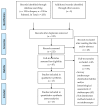Methods of Disinfecting Stethoscopes: Systematic Review
- PMID: 32182989
- PMCID: PMC7143198
- DOI: 10.3390/ijerph17061856
Methods of Disinfecting Stethoscopes: Systematic Review
Abstract
The aim of this systematic review was to investigate the effectiveness of various disinfection methods available for stethoscopes. In March 2019, we performed a search in PubMed and Scopus using the search terms: "reducing stethoscopes contamination" and "disinfection stethoscopes"; the Mesh terms used in PubMed were "Decontamination/methods" or "Disinfection/methods" and "Stethoscopes/microbiology". Selection criteria were: English language; at least one disinfection method tested. A total of 253 publications were screened. After title, abstract, and full-text analysis, 17 papers were included in the systematic review. Ethanol at 90%, Ethanol-Based Hands Sanitizer (EBHS), triclosan, chlorhexidine, isopropyl alcohol, 66% ethyl alcohol, sodium hypochlorite, and benzalkonium chloride have been proven to lower the presence of bacteria on stethoscopes' surfaces. In addition, alcohol wipes show effective results. A wearable device emitting ultraviolet C by Light-Emitting Diode (LED) resulted efficacious against common microorganisms involved in Healthcare Associated Infections. The cover impregnated with silver ions seemed to be associated with significantly higher colony counts. Instead, copper stethoscopes surface reduced bacterial load. The disinfection of stethoscopes appears to be essential. There are many valid methods available; the choice depends on various factors, such as the cost, availability, and practicality.
Keywords: 90% ethanol; UV-LED; benzalkonium; chlorhexidine; copper; healthcare-associated infections; isopropyl alcohol; sodium hypochlorite; stethoscope; triclosan.
Conflict of interest statement
Gabriele Messina is co-founder of a startup that produces a device for disinfecting stethoscopes.
Figures
References
-
- World Health Organization Report on the Burden of Endemic Health Care Associated Infection Worldwide. [(accessed on 7 February 2020)]; Available online: https://apps.who.int/iris/bitstream/handle/10665/80135/9789241501507_eng....
Publication types
MeSH terms
LinkOut - more resources
Full Text Sources
Medical


